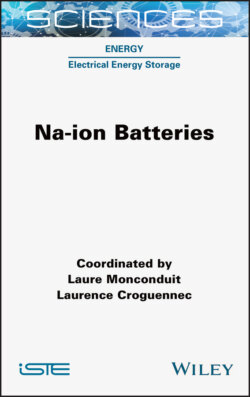Читать книгу Na-ion Batteries - Laure Monconduit - Страница 36
1.4.2. P2-Na2/3[Mn,Co,M]O2
ОглавлениеAs mentioned above, P2-type single 3d transition metal systems are found in only P2-Na2/3VO2, P2-Na0.6Mn0.9O2, P’2-Na2/3MnO2 and P2-Na2/3CoO2. Since NaxMnO2 delivers the largest reversible capacities of >200 mAh g−1 among single 3d transition metal P2-type systems (Kumakura et al. 2016), various solid solutions are synthesized based on P’2-Na2/3MnO2 and P2-Na2/3CoO2 as parent oxides and their Na (de)intercalation properties have been extensively investigated in Na cells.
A solid solution between P’2-Na2/3MnO2 and P2-Na2/3CoO2 is crystallized in any ratio of Mn/Co (Paulsen and Dahn 1999; Wang et al. 2013). From the late 1990s to the early 2000s, the solid solution was studied as positive electrode materials for Li-ion batteries after Li+/Na+ exchange (Paulsen and Dahn 1999; Lu and Dahn 2001b; Eriksson et al. 2003). Na intercalation properties of the sodium solid solution were first reported in P2-Na2/3Mn1/3Co2/3O2 by Carlier et al. (2011). P2-Na2/3Mn1/3Co2/3O2 delivers a reversible capacity of 112 mAh g−1 in the range of 1.5–4.0 V, as shown in Figure 1.14. The voltage profiles of P2-Na2/3Mn1/3Co2/3O2 are relatively smooth except for the voltage jump at x = 2/3 and 1/2 in P2-NaxMn1/3Co2/3O2 compared to the end-members of P’2-Na2/3MnO2 and P2-Na2/3CoO2, suggesting that the phase transitions and Na+/vacancy ordering in the Mn/Co-disordered phase are of less significance (Beck et al. 2014). According to XAS data of Na2/3Mn1/3Co2/3O2 during charge/discharge in Na cells (Cheng et al. 2014), LS Co3+ is oxidized into LS Co4+ by Na extraction and HS Mn4+ is maintained during charging to 4.0 V. On discharge to 2.5 V, LS Co4+ is reversibly reduced into LS Co3+. P2-Na2/3Mn1/3Co2/3O2 can accommodate more Na in the structure and both HS Mn4+ and LS Co4+ were reported to reduce into HS Mn3+ and HS Co2+, respectively, with major modification of hybridization between M 3d and O 2p orbitals by Na insertion on discharge below 2.5 V. The electronic structures significantly change with the formation of Jahn–Teller active Mn3+ and the reduction from LS-Co3+ to HS-Co2+ on discharge, resulting in much lower voltage than P2-Na2/3CoO2 below 2.5 V in the Na cells (Cheng et al. 2014; Watanabe et al. 2019). The extra 0.16 Na insertion into Na2/3Mn1/3Co2/3O2 and the large reversible capacity on discharging from 2.5 to 1.25 V is attractive, but Na compensation is necessary for the practical use. Even for P2-Na2/3[Mn,Co,Ni]O2, the low working voltage and indispensableness of external Na compensation are drawbacks.
